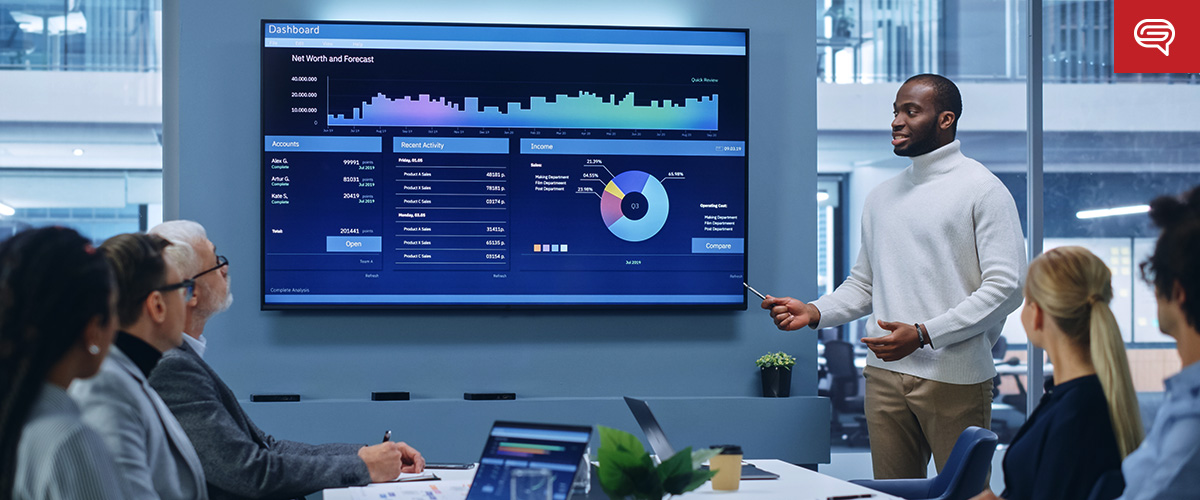Outsourcing has become a common practice among businesses—and the creation of presentations is no exception.
By hiring a freelance designer or a design agency, businesses can gain advantages, such as knowledge and skill, cost efficiency, access to cutting-edge technology, and a new perspective.
Need a Presentation Designed?
Click Here To View Our Amazing Portfolio
Design experts with the latest design skills can bring a fresh perspective to the table and create visually appealing, interactive, and engaging presentations that align with a company’s branding and messaging and communicate its message. Therefore, outsourcing the creation of presentations has its advantages; however, it is crucial to weigh the pros and cons of hiring a freelancer or a presentation design agency before deciding which one to hire.
Pros of working with a freelancer
Specialized expertise
Working with a freelancer who is an expert in a specific field, such as illustration or branding, can be an advantage for businesses with specific projects related to that field.
Freelancers who specialize in a particular design area are more likely to have the skills, knowledge, and experience to deliver high-quality work that meets the specific project requirements.
Flexibility in scheduling
Freelancers offer flexibility in scheduling that can be beneficial for businesses that have tight deadlines or need to make last-minute changes to their presentations.
As freelancers work independently, they can schedule their work around other commitments, allowing them to accommodate urgent requests more easily.
Lower costs
Freelancers charge lower rates than design agencies since they have lower overhead costs. They don’t pay for office space, equipment, or staff.
Businesses on a tight budget benefit from low service rates since they can get professional design work without breaking the bank. Moreover, many freelancers are willing to negotiate, resulting in more savings.
Personalized attention
Businesses with specific design needs can benefit from working with freelancers as they offer personalized attention.
This level of personalization allows businesses to have more control over the project and a hands-on approach to the design process.

Cons of working with a freelancer
Limited Resources
Freelancers may not have the same level of resources and expertise as a design agency—a drawback for businesses that need to create large or complex presentations.
The lack of resources can limit the scope of the design work that a freelancer can provide.
Lack of consistency in quality
The consistency of quality in work from freelancers can be uncertain which could be a drawback for businesses that require a consistent level of quality across all of their presentations.
Lack of oversight, resources, expertise, and experience can affect the quality of output of freelancers.
Limited ability to handle large projects
Most freelancers can’t handle large projects, which can disadvantage businesses that need to create large or complex presentations.
Freelancers typically work independently. They can’t access the same level of expertise, resources, or experience that a team of designers, copywriters, photographers, or project managers would have.
Dependence on one person for all design needs
When a business chooses to work with a freelancer, they rely on one individual to handle all of their design needs—this can be a disadvantage if the freelancer becomes unavailable or unable to complete the project.
Businesses need to consider the availability and reliability of the freelancer before engaging in a project.

Pros of working with a presentation design agency
Professional expertise
Agencies have a team of experts at their disposal. These experts have skills in different areas of design, such as branding, graphic design, and animation.
With a team of experts, agencies can handle large and complex projects easily. They can also ensure consistent quality across all deliverables, which is important for businesses that require a consistent level of quality across all of their presentations.
Resources and technology
Agencies have the advantage of having access to the latest design tools and technology, allowing them to stay updated with the latest industry trends and advancements.
With cutting-edge tools and technology, agencies can craft visually stunning and engaging presentations that seamlessly align with a company’s branding and messaging. This allows them to effectively convey the message, leaving a powerful and lasting impact on the audience.
Scalability
Working with an agency means businesses have access to a team of experts with a wide range of skills and experience. This allows them to handle large-scale projects with multiple deliverables, ensuring consistent quality throughout the project.
Agencies also can scale up or down their resources as needed, meaning that businesses can have the flexibility to adjust their design needs as the project progresses. This can be especially beneficial for businesses with complex projects with multiple stakeholders, tight deadlines, or the need to make last-minute changes.
Quality assurance
Agencies have established systems for quality assurance to guarantee that the final product meets the client’s standards and expectations.
They ensure that the deliverables are of the highest quality and that any issues or concerns are addressed and resolved on time. As a result, businesses get peace of mind that value consistency and attention to detail in their presentations.
Account management
Agencies have dedicated account managers who act as the primary point of contact for clients. This ensures clear communication and coordination throughout the project, making it easier for businesses to share their needs and feedback.
Having a dedicated account manager also allows for a more efficient workflow, as the manager can act as the liaison between the client and the agency’s design team, ensuring that the project stays on track and is completed on time. This can be especially beneficial for businesses with multiple stakeholders or that need to make last-minute changes.
Need a Presentation Designed?
Click Here To View Our Amazing Portfolio
Cons of working with a presentation design agency
Potentially higher costs
One potential downside of working with an agency is that they tend to charge higher rates than freelancers. This can make it less cost-effective for businesses that are operating on a tight budget.
However, it’s important to keep in mind that the cost of working with an agency often includes not only the design work itself but also the expertise and resources of a team of specialists, as well as the added oversight and quality assurance processes in place to ensure that deliverables meet the client’s requirements and expectations.
When working with a presentation design agency, it is important to keep in mind that the rates they charge may be negotiable.
Businesses should be prepared to discuss their budget constraints and what they are looking to achieve with their presentation. By providing the agency with clear objectives, budgets, and timelines, the agency can better understand the scope of the project and adjust its rates accordingly.
By keeping an open line of communication and being transparent about their needs, businesses can negotiate with the agency to find a solution that works for both parties.
Less flexibility
Working with an agency often involves a more structured and formal process, which may not be as flexible as working with a freelancer. This can be a disadvantage for businesses that need to make last-minute changes or have tight deadlines.
However, agencies often have dedicated account managers who act as a single point of contact for the client, ensuring smooth communication and coordination between the client and the agency’s team. This can make it easier for businesses to work with the agency and make changes to their presentations as needed.
Additionally, agencies often have a team of experts in different areas of design, such as branding, graphic design, and animation, which can help ensure that the final deliverables meet the client’s requirements and expectations, avoiding potential delays and revisions in the project.
Limited communication with the designer
When working with a design agency, businesses have limited direct communication with the designers, making it difficult to discuss specific design instructions.
However, when businesses hire a presentation design agency, the agency assigns a dedicated account manager who acts as a single point of contact and is responsible for coordinating with the team of designers and other experts throughout the project.
As a result, the business receives high-quality presentations that meet its requirements and are free from errors and inconsistencies.
.

Outsourcing the creation of presentations can provide businesses and organizations with a professional and polished product that can make a strong impression and effectively communicate important information. Hiring a professional designer or agency can bring fresh perspectives and specialized expertise to a presentation project, ultimately leading to a more successful outcome.
































